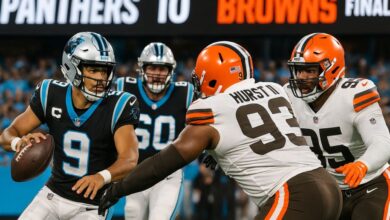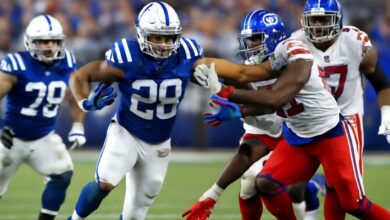Los Angeles Rams vs New York Jets Match Player Stats: Full Game Breakdown

On December 22, 2024, at MetLife Stadium in East Rutherford, New Jersey, the Los Angeles Rams earned a gritty 19-9 victory over the New York Jets. The matchup was a battle of resilience, defined by defensive discipline, clutch special-teams play, and timely execution. The Jets struck early but the Rams weathered the storm, taking over late to secure a significant win that demonstrated balance and poise on both sides of the ball.
Game Overview and Team Context
The Jets came out strong in the first quarter, opening the game with an impressive 99-yard touchdown drive capped by quarterback Aaron Rodgers connecting with star receiver Davante Adams for an 11-yard score. The early touchdown gave New York a 6-0 lead and momentum that carried into the second quarter. However, the Rams’ defense began adjusting quickly, limiting big plays and forcing longer drives that stalled in the red zone.
Despite trailing 9-6 at halftime, the Rams controlled the second half through a combination of smart offensive play-calling and defensive pressure. The Jets out-gained Los Angeles in total yards—321 to 242—but efficiency, field position, and turnovers ultimately told the story. Time of possession leaned slightly in the Jets’ favor at just over 32 minutes, yet the Rams’ 27 minutes with the ball were enough to craft three scoring drives that mattered most.
Rams Key Player Statistics
Matthew Stafford (Quarterback):
Stafford completed 14 of 19 passes for 110 yards with one touchdown and one interception, finishing with a passer rating above 80. Though his numbers were modest, Stafford managed the game effectively. His precision passing in crucial downs, particularly late in the fourth quarter, kept the offense balanced and unpredictable.
Kyren Williams (Running Back):
Williams delivered a standout performance, rushing 23 times for 122 yards at an average of 5.3 yards per carry and scoring one touchdown. His ability to sustain drives and punish the Jets’ defensive line was pivotal. Williams’ consistent production opened up play-action opportunities for Stafford and helped the Rams control the tempo.
Puka Nacua (Wide Receiver):
Nacua caught 8 passes for 56 yards on 9 targets. His presence in the short-to-intermediate passing game gave Stafford an outlet against the Jets’ strong pass rush. While Nacua didn’t break free for long gains, his reliability on third down extended key drives.
Tyler Higbee (Tight End):
Returning from injury, Higbee had a limited statistical line—just one reception for 11 yards—but that single catch was the game-winner. His touchdown grab midway through the fourth quarter gave the Rams a 16-9 lead and marked his successful return to action. Higbee’s timing, chemistry with Stafford, and red-zone efficiency made the difference when the game was on the line.
Special Teams:
Kicker Joshua Karty was flawless, converting two field goals including a critical 45-yarder late in the fourth quarter to stretch the Rams’ lead. Receiver Jordan Whittington made key plays on special teams, downing a punt inside the 1-yard line and recovering a muffed punt in the final minutes—contributions that underscored the importance of field position throughout the contest.
Jets Key Player Statistics
Aaron Rodgers (Quarterback):
Rodgers completed 28 of 42 passes for 256 yards with one touchdown and no interceptions. His veteran composure kept the Jets competitive, but a costly fourth-quarter strip-sack by Rams cornerback Kam Curl proved decisive. The turnover deep in Jets territory led directly to the Rams’ go-ahead score.
Breece Hall (Running Back):
Hall recorded 14 carries for 52 yards, averaging just over 3.7 per rush, and added 5 receptions for 38 yards. Despite flashes of power running, he struggled to find consistent lanes behind an offensive line that failed to dominate the trenches.
Davante Adams (Wide Receiver):
Adams caught 7 passes for 68 yards and a touchdown—the Jets’ only trip to the end zone. His chemistry with Rodgers was evident, particularly on timing routes and third-down plays, but the Rams’ secondary limited his yards after catch, neutralizing his big-play threat after the opening drive.
Situational and Turning-Point Analysis
The game’s defining moment came early in the fourth quarter. With the score tied at 9-9, the Jets faced a critical fourth-and-4 at the Rams’ 13-yard line. Opting to go for it, Rodgers’ pass fell incomplete—one of several fourth-down failures that haunted New York throughout the game.
Moments later, Kam Curl broke through on a blitz and strip-sacked Rodgers, giving Los Angeles possession deep in Jets territory. Three plays afterward, Stafford hit Higbee in the flat for the go-ahead touchdown. The Rams added Karty’s 45-yard field goal minutes later, turning a defensive stand into a two-possession cushion.
Although the Jets out-performed Los Angeles in yardage and ball control, they struggled in the red zone. Converting only 2 of 5 fourth-down attempts and failing to score after halftime exposed ongoing inefficiencies in their offensive execution. The Rams, on the other hand, converted crucial plays despite limited total offense—a testament to efficient situational football.
What the Stats Really Tell Us
This contest illustrated how efficiency and discipline can outweigh raw production. The Rams, with fewer yards and fewer first downs, managed to generate more points through timely play-calling and strong fundamentals. Williams’ 122 rushing yards weren’t just numbers—they represented control of tempo and physical dominance at the line of scrimmage.
Stafford’s passing may not have filled the stat sheet, but his decision-making under pressure was exemplary. By limiting turnovers and delivering accurate short throws, he allowed the Rams to sustain drives without exposing the offense to unnecessary risks. Higbee’s lone catch encapsulated the Rams’ approach—patient, opportunistic, and surgical when it mattered.
For the Jets, Rodgers and Adams displayed the chemistry fans expected, but the supporting cast fell short. Hall’s limited rushing success reflected an inability to win battles at the line. Rodgers’ strip-sack symbolized the broader theme: solid execution undone by a single critical lapse. Out-gaining the opponent yet producing only nine points speaks volumes about red-zone inefficiency and situational breakdowns.
Defensive and Special-Teams Impact
Defense and special teams often decide close games, and this was no exception. The Rams’ defensive unit, led by Kam Curl and Ernest Jones, excelled in containing the Jets’ running game and applying late-game pressure on Rodgers. The turnover they forced shifted both momentum and field position decisively.
On special teams, the Rams outperformed their opponents in nearly every facet. Karty’s reliability, Whittington’s field-position heroics, and solid coverage units combined to tilt the game’s balance. The Jets, by contrast, struggled with execution—miscues on punts and missed opportunities on kick returns compounded their offensive frustrations.
Implications Moving Forward
The Rams’ victory served as a blueprint for playoff-ready football: steady quarterback play, a dominant rushing attack, clutch defense, and special-teams excellence. It showcased their ability to win ugly—a quality every contender needs in December. The team’s balance suggests they can handle both defensive slugfests and high-scoring battles.
For the Jets, the loss exposed familiar issues. Despite Rodgers’ presence and flashes of chemistry with Adams, the offense remains inconsistent. Their inability to finish drives, combined with costly turnovers, continues to undermine their efforts. While the defense remains formidable, offensive inefficiency and coaching decisions—like aggressive fourth-down calls—will need addressing if the Jets hope to improve next season.
Final Thoughts
The Los Angeles Rams vs New York Jets matchup may not have been an offensive showcase, but it was a masterclass in complementary football. Every key statistic told a story of control, discipline, and seizing the moment. Williams’ 122 rushing yards, Higbee’s timely touchdown, and Curl’s defensive heroics symbolized the Rams’ ability to deliver in crucial junctures.
For the Jets, Rodgers and Adams continued to perform as stars, but football remains a team game—and one or two execution lapses can rewrite the final score. In this case, the Rams’ cohesion overcame the Jets’ statistical edge, proving that timing, balance, and grit often win in December.
Thanks for reading this comprehensive analysis brought to you by Blog Loom — your home for in-depth sports storytelling and detailed stat-based insights.




